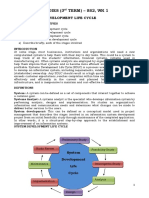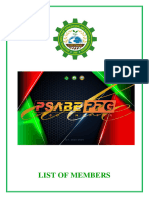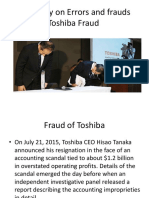Erp Related Technologies
Erp Related Technologies
Uploaded by
Foru KharaCopyright:
Available Formats
Erp Related Technologies
Erp Related Technologies
Uploaded by
Foru KharaCopyright
Available Formats
Share this document
Did you find this document useful?
Is this content inappropriate?
Copyright:
Available Formats
Erp Related Technologies
Erp Related Technologies
Uploaded by
Foru KharaCopyright:
Available Formats
ERP & Related Technologies
Limitation of ERP
Managers cannot generate custom reports or queries without help from a programmer.
This restricts them from obtaining information quickly and act on it in this competitive market.
ERP system provide current status only such as open orders. The data in ERP is not integrated with other enterprise or division system and does not include external intelligence.
Overcoming the Limitations
There are many technologies that help to overcome these limitations. These technologies when used in conjunction with ERP system help for better decision making and also help in overcoming limitations of ERP. Organizations are constantly innovating methods to improve organizational efficiency, reduce cost, provide high quality, personalized customer service, customer satisfaction , increased profit margin.
Companies use these technologies to integrate it into core of their business planning and are ready to face the challenges of conducting business in this
Technologies
Some of these technologies when integrated with ERP system , enable companies to do business at internet speed. These technologies are :
Business Process Re-engineering (BPR).
Management Information System (MIS). Decision Support System (DSS).
Executive Information Systems (EIS). Data Warehousing. Data Mining. On-line Analytical Processing (OLAP).
Business Process Re-engineering (BPR).
Dr. Michael Hammer defines BPR as the fundamental rethinking and radical redesign of business processes to achieve dramatic improvements in critical, contemporary measures of performance such as cost, quality, services and speed. One of the main tools for making this change is the Information Technology(IT). Any BPR effort that fails to understand the importance of IT, and goes through the pre-BPR analysis and planning phases without considering the various IT options available, is bound to crash during take off.
Management Information System (MIS).
MIS is a computer based system that optimizes the collection, collation, transfer and presentation of information throughout an organization, through an integrated structure of databases and information flow. MIS supports data processing functions of transaction handling and record keeping. MIS uses an integrated database Integrates the information flow between functional areas. MIS provides operational, tactical and strategic
Decision Support System (DSS).
Managers spend a lot of time and effort in gathering and analyzing information before making decisions. Decision support systems are interactive information systems that rely on an integrated set of user-friendly software and hardware tools, to produce and present information targeted to support management in the decision making process. DSS allow manager to improve the quality of their decision.
DSS facilitates decision making process, choose between alternatives; automatically rank the alternatives.
DSS
designed to address semi-structured and unstructured problems. supports decision-making at the top management level. interactive, user-friendly.
Difference between MIS & DSS.
Executive Information System (EIS)
EIS is better and sophisticated DSS. EIS is a DSS especially made for senior level executives.
concerned with how decisions affect the entire organization.
An EIS takes the following into considerations:
vision and mission & the company goals. Strategic planning and objectives. Organizational structure. Crisis management/ contingency planning.
Data Warehousing
Operational data in the database increases as time passes Affects the performance of the ERP system. Better to archive data once its use is over. E.g. Once the financial year is over, the daily transaction data can be archive. As volume of data in the database increases , the performance of database and related application decreases. Solution :- separate operational data from non operational data (not archive data).
A data warehouse is designed to support decision making in organization. Data warehouse is a combination of different database across the organization. the data stored for the business analysis can be accessed most effectively by separating it from the data in operational systems. High performance and quick response time.
A data mart is a collection of database enabling managers for better decision making.
Usually smaller and focus on particular dept.
Data Mining
Data mining is the process of identifying valid, novel, potentially useful and ultimately comprehensible information from databases that is used to make crucial business decisions. Need for data mining :
enormous volume of existing and newly appearing data that require processing. The amount of data accumulated each day by various businesses, scientific and governmental organizations around the world is daunting. Research organizations, academic institutions and commercial organizations create and store huge amounts
Data mining is sorting through data to identify certain patterns and establish relationships among data. E.g . Data mining s/w can help retail companies to find customers with common interest. Data mining parameters include :
Association
Sequence Classification Clustering Forecasting (predictive analysis)
On-Line Analytical Processing (OLAP)
OLAP is a decision support s/w that allows users to quickly analyze information that has been summarized into multidimensional views.
OLAP is a s/w tool that provides analysis of data stored in the database.
Used to perform trend analysis on sales and financial information, marketing analysis, financial reporting and consolidation, budgeting and planning. Used in Data Mining. OLAP can be defined in five words Fast Analysis of Shared Multi-dimensional Information.
OLAP
FAST :
deliver most responses to users within about 5 seconds.
ANALYSIS :
system can cope with any business logic and statistical analysis relevant for the application and the user.
SHARED :
system implements all the security requirements for confidentiality. provide concurrent update locking at an appropriate level.
MULTI-DIMENSIONAL :-
OLAP is used in applications such as :
Product profitability
Pricing analysis
Activity based costing Manpower planning Quality analysis
Supply Chain Management (SCM)
A supply chain is a network of facilities and distribution options that performs the function of procurement of materials, transformation of these materials into intermediate and finished products and the distribution of these finished products to the customers. SCM plans all movement and storage of raw materials, work in progress, inventory and finished goods from point of origin to point of consumption. Need for SCM :
All the depts in organization along with supply chain operated independently.
CRM
GIS
Refer Alexis Leon PPTs
You might also like
- Business Intelligence NotesDocument88 pagesBusiness Intelligence NotesManjit Singh100% (1)
- Chapter 8 Enterprise Business SystemsDocument6 pagesChapter 8 Enterprise Business SystemsErfan KhanNo ratings yet
- Business Research Methods Questions Paper PDFDocument24 pagesBusiness Research Methods Questions Paper PDFNisha pramanik100% (1)
- Information Management Unit I Mba Anna UniversityDocument62 pagesInformation Management Unit I Mba Anna UniversityViswanath T KNo ratings yet
- Approaches of MisDocument2 pagesApproaches of MisDeepak100% (4)
- Role of A System AnalystDocument3 pagesRole of A System AnalystEruNo ratings yet
- Mobile Computing ExamDocument2 pagesMobile Computing ExamNelson Ochieng Odunga100% (1)
- Converging Currents of GlobalizationDocument40 pagesConverging Currents of GlobalizationJuliean Torres AkiatanNo ratings yet
- Characteristics of MISDocument6 pagesCharacteristics of MISnblroshanNo ratings yet
- Chapter 1 (Fundamentals of Business Analytics)Document20 pagesChapter 1 (Fundamentals of Business Analytics)aqsakhan1129910No ratings yet
- Impact of Computers On MISDocument1 pageImpact of Computers On MISPrasanna Sharma100% (1)
- IT - ERP NotesDocument103 pagesIT - ERP Notesristadi_asoyNo ratings yet
- Chapter 2 - System Development ApproachesDocument59 pagesChapter 2 - System Development ApproachesFaris Ajwad100% (10)
- Management Information SystemDocument172 pagesManagement Information SystemSumanNo ratings yet
- Management Information SystemDocument14 pagesManagement Information SystemMonisha ParekhNo ratings yet
- MIS & Other SubsystemsDocument89 pagesMIS & Other SubsystemsDebi Mohapatra33% (3)
- BA7205 Information ManagementDocument20 pagesBA7205 Information ManagementPalani Arunachalam0% (1)
- System Development Life CycleDocument3 pagesSystem Development Life CycleOluwatomisin Odunayo100% (2)
- BBA MIS PPT-2 Management Information System and Management ProcessesDocument67 pagesBBA MIS PPT-2 Management Information System and Management Processeskrishna rakholiya100% (1)
- Chapter 4Document29 pagesChapter 4Prudhvinadh Kopparapu100% (1)
- Business Communication Unit 3Document50 pagesBusiness Communication Unit 3Monika Saxena0% (1)
- ERP and Related TechnologiesDocument6 pagesERP and Related Technologiessadanand14367% (3)
- Mis SyllabusDocument1 pageMis SyllabusPrasanth KumarNo ratings yet
- Chapter 4 - Internet of Things (IOT)Document48 pagesChapter 4 - Internet of Things (IOT)Lee HailuNo ratings yet
- Ba Unit 2 NotesDocument16 pagesBa Unit 2 Notesprem nathNo ratings yet
- Social Issues in Tech. MGMTDocument2 pagesSocial Issues in Tech. MGMTUtshav PoudelNo ratings yet
- Conversion of Mannual MIS Into Computer Is Ed MISDocument10 pagesConversion of Mannual MIS Into Computer Is Ed MISArun Mishra100% (2)
- ERPDocument19 pagesERPpounupr@gmail.comNo ratings yet
- Why Study Information SystemsDocument12 pagesWhy Study Information SystemsmykadiosoNo ratings yet
- Important Questions of Information Technology BBA & B.Com With AnswersDocument60 pagesImportant Questions of Information Technology BBA & B.Com With AnswersRishit GoelNo ratings yet
- Dbms MBA NotesDocument125 pagesDbms MBA NotesAnoop Skaria Paul50% (2)
- Linear Programming Problem: Basic RequirementsDocument5 pagesLinear Programming Problem: Basic RequirementsNusrat Jahan MoonNo ratings yet
- Survey QuestionnaireDocument16 pagesSurvey QuestionnaireNageshwar SinghNo ratings yet
- Chapter 4 - ERP A Manufacturing PerspectiveDocument18 pagesChapter 4 - ERP A Manufacturing PerspectiveHarold Falip100% (1)
- Model Ba4030 E-Business.i IDocument4 pagesModel Ba4030 E-Business.i Ilakshman rajNo ratings yet
- Scientific Management: (Contribution of F.W. Taylor)Document2 pagesScientific Management: (Contribution of F.W. Taylor)Sharmaine Grace FlorigNo ratings yet
- The Compelling Need For Data WarehousingDocument36 pagesThe Compelling Need For Data WarehousingAnonymous Ck9Og8UEqzNo ratings yet
- Management Information System - Planning, Designing and Implementation of MisDocument12 pagesManagement Information System - Planning, Designing and Implementation of Miscompiler&automataNo ratings yet
- Business Analytics Lab Summative 1Document5 pagesBusiness Analytics Lab Summative 1Kuroko TetsuNo ratings yet
- Unit - Ii Creativity and Entrepreneurial Plan Idea Generation, Screening and Project IdentificationDocument9 pagesUnit - Ii Creativity and Entrepreneurial Plan Idea Generation, Screening and Project Identificationmba departmentNo ratings yet
- Management Information System Questions and Answers BBADocument140 pagesManagement Information System Questions and Answers BBAShraddha NepalNo ratings yet
- System Development Models PDFDocument25 pagesSystem Development Models PDFNancy Dhanuka100% (1)
- Enterprise and Global Management of Information TechnologyDocument19 pagesEnterprise and Global Management of Information TechnologychalaNo ratings yet
- System Analysis, System Development and System ModelsDocument56 pagesSystem Analysis, System Development and System Modelsmaaya_ravindra100% (1)
- Disadvantages of Traditional File SystemA Traditional File System Has The Following DisadvantagesDocument3 pagesDisadvantages of Traditional File SystemA Traditional File System Has The Following DisadvantagesMisheckNo ratings yet
- Decision Support Systems and Business Intelligence PDFDocument25 pagesDecision Support Systems and Business Intelligence PDFlcm3766l100% (1)
- MIS PPT System Development Life Cycle (SDLC) NikhilDocument12 pagesMIS PPT System Development Life Cycle (SDLC) NikhilNikhil thomas Abraham100% (1)
- BA7205 INFORMATION - MANAGEMENT - PDF Notes PDFDocument168 pagesBA7205 INFORMATION - MANAGEMENT - PDF Notes PDFjohnpratheesh67% (3)
- ERP Unit 15 Future Directions in ERP PPT FinalDocument13 pagesERP Unit 15 Future Directions in ERP PPT FinalAnonymous bTh744z7E6100% (1)
- Unit I: Business Information SystemsDocument14 pagesUnit I: Business Information SystemsRodel Novesteras ClausNo ratings yet
- Mis Unit III-2Document20 pagesMis Unit III-2Meenakshi Pawar100% (2)
- The 6 Types of Information Systems and Their ApplicationsDocument46 pagesThe 6 Types of Information Systems and Their ApplicationsShwa BeliNo ratings yet
- Pitfalls of MISDocument3 pagesPitfalls of MISangel190693No ratings yet
- Management Information Systems (MIS)Document33 pagesManagement Information Systems (MIS)Muhammad HijabNo ratings yet
- Assignment Expert SystemDocument14 pagesAssignment Expert Systemksmann88100% (1)
- Emerging Technology PPT - StsDocument20 pagesEmerging Technology PPT - StsHenok ZerihunNo ratings yet
- Decomposition: TechniqueDocument10 pagesDecomposition: TechniqueKathiravanNo ratings yet
- Unit - 2 PDFDocument2 pagesUnit - 2 PDFBandosNo ratings yet
- BBA MIS ch4Document62 pagesBBA MIS ch4FrankNo ratings yet
- B. How Do Conventional Application Packages Differ From ERP Packages?Document5 pagesB. How Do Conventional Application Packages Differ From ERP Packages?pad75No ratings yet
- Chapter 3Document13 pagesChapter 3poojamudNo ratings yet
- MplsDocument124 pagesMplsmgitecetechNo ratings yet
- List of MembersDocument8 pagesList of Memberselement EgNo ratings yet
- Certifications - Process - Document - For - Associates V2.0 PDFDocument28 pagesCertifications - Process - Document - For - Associates V2.0 PDFMadhuri MalayathiNo ratings yet
- 2014 Book SituationalMethodEngineering PDFDocument323 pages2014 Book SituationalMethodEngineering PDFDironNo ratings yet
- Case Study On Errors and FraudsDocument9 pagesCase Study On Errors and FraudsHariharan ShettyNo ratings yet
- SNBP WakadDocument4 pagesSNBP WakadAshwini MaliNo ratings yet
- Developing A Global VisionDocument44 pagesDeveloping A Global VisionAndrea DawnNo ratings yet
- Everything You Need To Know About The Conjugation of "Essere" in ItalianDocument1 pageEverything You Need To Know About The Conjugation of "Essere" in ItalianTatjana MilosavljevicNo ratings yet
- Addis Et Al. - 2019 - Semi-Automatic Generation of Cognitive Science TheoriesDocument14 pagesAddis Et Al. - 2019 - Semi-Automatic Generation of Cognitive Science TheoriesBruno da Rocha BragaNo ratings yet
- Class II AS - 2023-24Document7 pagesClass II AS - 2023-24محمدضيأ الدينNo ratings yet
- Research MatrixDocument2 pagesResearch MatrixBintang Cahya Aprilia Nagita100% (2)
- Liveability in Social Housing: Three Case-Studies in FlandersDocument24 pagesLiveability in Social Housing: Three Case-Studies in FlandersMustafa OmarNo ratings yet
- News Article SummaryDocument4 pagesNews Article Summaryapi-550030025No ratings yet
- (13148710 - Journal of Theoretical and Applied Mechanics) Mechanical Systems of Cosserat-ZhilinDocument16 pages(13148710 - Journal of Theoretical and Applied Mechanics) Mechanical Systems of Cosserat-ZhilinAhmed HussainNo ratings yet
- Sekolah Menengah Kebangsaan Sungai Layar, 08000 SG Petani, KedahDocument4 pagesSekolah Menengah Kebangsaan Sungai Layar, 08000 SG Petani, KedahAsoda VaNo ratings yet
- Palay Inc Vs ClaveDocument2 pagesPalay Inc Vs ClaveBelzer ResurreccionNo ratings yet
- Purpose of Listening SkillDocument10 pagesPurpose of Listening SkillAishwarya Suma0% (1)
- 2023 Daniel T Warren V Gary A Dickson Et Al - Responding PapersDocument29 pages2023 Daniel T Warren V Gary A Dickson Et Al - Responding PapersDaniel T. WarrenNo ratings yet
- AAIR BOA - Complete File - November 23Document54 pagesAAIR BOA - Complete File - November 23Rex LimNo ratings yet
- Brahma Sutra CatusutriDocument435 pagesBrahma Sutra CatusutriSathasivam GovindasamyNo ratings yet
- Permutations OnlyDocument26 pagesPermutations OnlyazuraanasNo ratings yet
- Brochure Simatic Wincc v72 enDocument8 pagesBrochure Simatic Wincc v72 enjeanfmirandaNo ratings yet
- POQ MGMTDocument53 pagesPOQ MGMTAruna FeltzNo ratings yet
- Lecture 22CAs20Document29 pagesLecture 22CAs20mzNo ratings yet
- Utica NY Daily Press 1966 - 7474Document1 pageUtica NY Daily Press 1966 - 747411kvnptrckNo ratings yet
- CVDocument1 pageCVErik AndersonNo ratings yet
- Hostel Management SystemDocument11 pagesHostel Management SystemMaryamNo ratings yet
- Bertrand Russell - What I Have Lived ForDocument2 pagesBertrand Russell - What I Have Lived Formetalover36100% (1)
- How Far Is 7.5 On The Beep Test in KM - Google SearchDocument2 pagesHow Far Is 7.5 On The Beep Test in KM - Google SearchRakhmat Ari WibowoNo ratings yet

























































































